
In a year when winter has been particularly long, cold, and wet, it’s not unusual to enter spring with a distressed lawn. The high pressure produced by intense winter conditions creates a lot of opportunities for pests and diseases to move in and cause problems.
Here are a few common issues we observe in the Clark County and Portland metro area. If you’re seeing bare patches, brown patches, or circular patches of pink or white, you may be facing one of the following:
Red Thread
Red thread, or Laetisaria fuciformis, is an opportunistic lawn disease. Its name comes from thin red strands this fungus sends out from the tips of infected grass blades. If your lawn and soil isn’t well drained, a wet winter can throw the door wide open for problems due to this infection. Prolonged exposure to moisture is the primary cause of red thread in unhealthy turf.
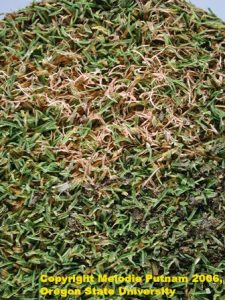
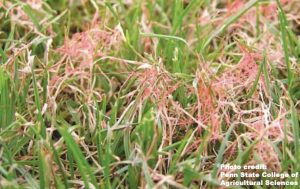
From a distance, you may notice circular patches of pinkish grass ranging up to 8 inches in diameter. It’s important to take a closer look to see if ‘threads’ are present, though, as there are similar symptoms that result from other kinds of issues.
The good news is that red thread does not destroy grass roots and crowns. There is potential for full recovery if you commit to thorough treatment. The best way to ward off future infections of red thread is by conditioning your soil, providing good drainage, and sticking to a proven, consistent maintenance plan.
Pink Snow Mold
Pink snow mold, as its name implies, is associated with extended snow cover. Like red thread, it’s caused by a fungus, Microdochium nivale. Pink and white foamy fungal spores sit on top of infected grass blades, creating pink circular splotches across the lawn. In a prolonged wet and snowy winter, it can result in severe damage to turf.
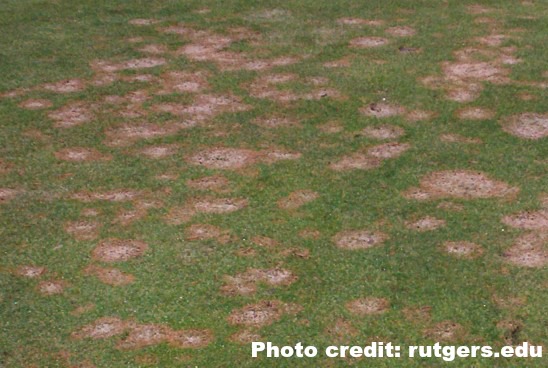
The road to recovery begins with skilled thatching and aeration. Committing to best practices for fertilization, drainage, snow management, and pest control is the key to keeping damage from snow mold to a minimum, whatever future winters may bring.
Crane Fly
Crane fly infestations are notorious for their potential to kill an entire lawn. While adult crane flies swoop and fly around the yard, it’s the eggs they lay down that spell serious trouble. Crane fly larvae (also known as ‘leatherjackets’) are 1-inch long and tan or grayish white in color. The hungry larvae wreak havoc on turf as they feast on grass roots and crowns.
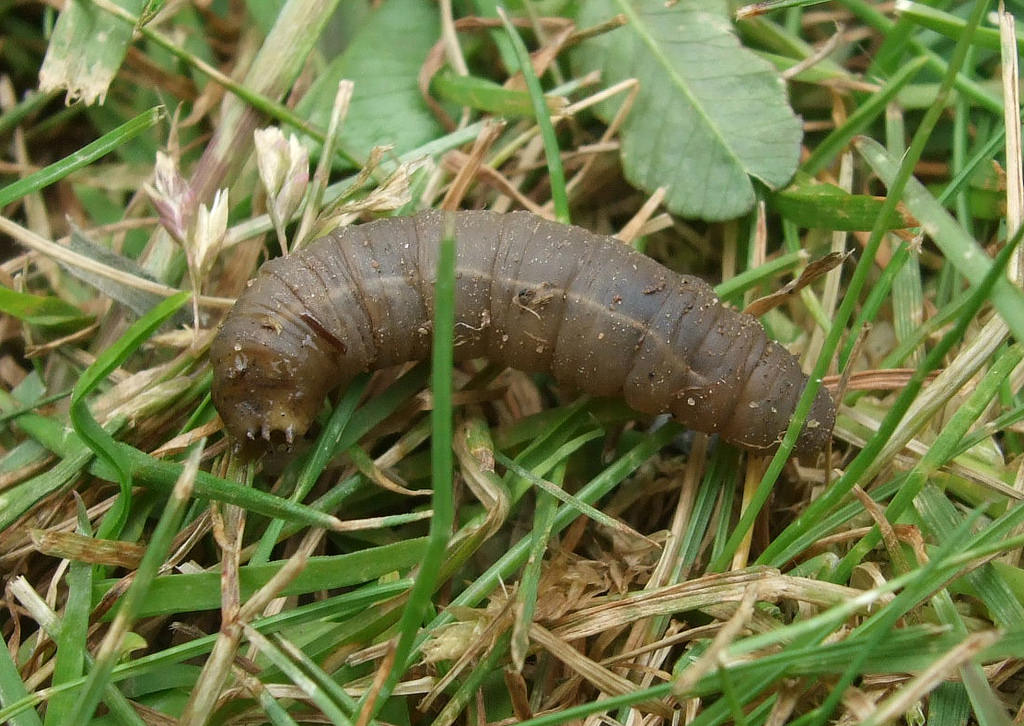
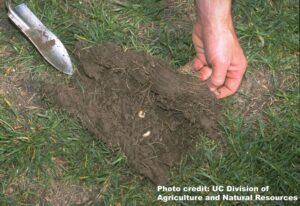
Look for patches of damaged grass that may appear to grow together and spread. Peeling back the soil will reveal whether crane fly larvae are to blame. While a healthy lawn can handle a medium population of larvae, a teeming infestation means it’s time to call for help.
The encouraging thing about battling crane fly is the potential for treatment and full recovery. The crew at Frontier Landscaping has generated impressive results for lawn restoration and would be happy to work with you to save your lawn if you’re dealing with an outbreak this year.
Maintaining healthy turfgrass is the #1 way to prevent future pest and disease issues!
Lawn Rescues and Revamps
In the moist Pacific Northwest, especially after a very wet winter, it’s not uncommon to have problems show up if your soil and grass haven’t been regularly maintained for optimal health.
If you’re in need of treatment, the Frontier Landscaping crew is expertly qualified to help you back to a thriving, healthy lawn. The process we have developed through years of local experience consistently produces successful, healthy turf.
Aeration
Aeration is a generic term for exposing soil to the air by removing plugs of soil from the turf. The openings created by aeration help water and nutrients move more easily through the soil.
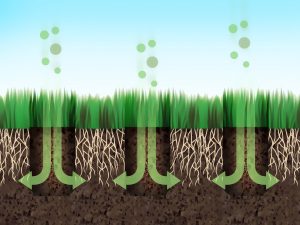
While it’s common practice to leave soil plugs in a lawn after aeration, the crew at Frontier Landscaping has determined that the most successful lawns are created when we pick up and dispose of the hardened plugs. This additional step allows topdressing to better penetrate the new holes in the soil, enhancing the entire aeration process overall. While it is a greater effort, this step has consistently shown itself to be an effective key to helping sick lawns bounce back quickly and look better than ever.
Additional benefits of aeration:
- Limits fertilizer runoff
- Improves ability to absorb water
- Slows buildup of thatch
- Builds strong root system and layer of topsoil
Frontier Landscaping recommends aeration once each year for all lawns to maintain great health.
Reseeding and Fertilization
Once soil has been aerated, ¼ to 1 inch of rich soil conditioner is applied. This mix works down through the new holes left by aeration and sets the lawn up for improved future drainage.
Why does this matter? Good soil texture promotes healthy turf. In turn, healthy turf is significantly less susceptible to disease.
Once soil has been treated, your lawn will be ready to be reseeded and fertilized. It’s not uncommon to see new grass emerging within a month of completion.
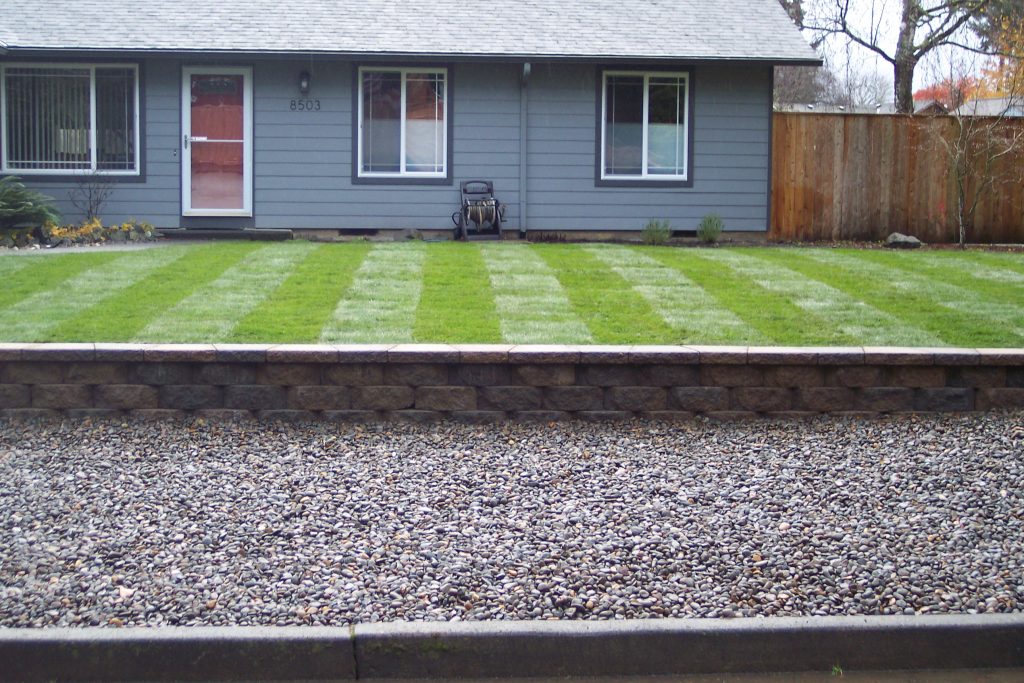
Intense seasons of wet weather can result in significant pest and disease pressure on lawns, especially if the grass isn’t robust and healthy to begin with.
If you find yourself facing ugly bare spots, remember that many issues are treatable if caught in time. Give us a call to learn about treatment options for your lawn. We’ll help you through and are happy to design a custom care plan for the future based on the specific needs of your landscape.
Ready for a winter lawn rescue? Call (360) 574-8979 or send us an email to arrange a consultation today.

Dry creek beds provide attractive, functional relief, especially if your landscape is plagued by standing water. In the wet PNW, drainage problems are a common headache. Do any of these sound familiar?
- Floo
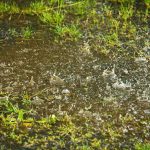 ded flower beds
ded flower beds
- Pooling water below a deck
- Swampy places in the lawn
- Puddles around a foundation
Leaving drainage issues unaddressed has serious consequences, from dead lawn and plants to costly repairs and decreased property value.
The Good News
Frontier Landscaping has years of experience designing and implementing features that effectively carry water away from problem areas. Dry creek beds are star performers, particularly in sloped terrain. They work twice as hard for a landscape by running water from Point A to B, and standing alone as an attractive feature in drier months of the year.
“Even property owners with no landscape drainage issues may choose to install a dry creek bed due to the elements of natural beauty in the way they look.”

Controlling Water Flow
Dry creek beds are an excellent choice for addressing places in the landscape that are hard-hit by heavy rains. While a flat place in the yard may benefit more from a simple lawn drain, gradients and hillsides need the water capacity and speed that a dry creek bed can provide during extreme conditions. Effectively redirecting the flow of water saves you from ongoing erosion and long-term damage.
Water-Wise Gardening
When property owners are looking for a greener way to landscape, dry creek beds play an exciting role. Different-sized rocks, boulders, and choice plantings give eye-pleasing texture to outdoor spaces, but require much less water than an expanse of lawn. While bark dust alone can look flat, a dry creek bed introduces definition and contrast. It’s aesthetically pleasing and earth-friendly — a winning combination.
Dry Creek Beds for Natural Beauty
We regularly install dry creek beds to add natural beauty to a landscape. Expertly balancing a few key ingredients (a natural shape, native plantings, multiple sizes of stone) brings a natural, organic flow to an area. The results are breathtaking in any season, wet or dry.
Additional Considerations
No two landscapes are exactly alike, and the solution that works for one may not work for another. While dry creek beds are particularly suited to slopes and hillsides, they aren’t usually the best choice for flat ground.
Other elements, like French drains, catch basins, and lawn drains also have a part to play — and that’s just the beginning. Frontier’s installation team has years of experience solving drainage problems for local property owners.
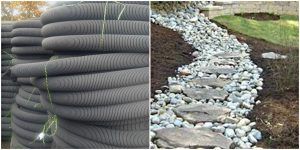
French drain pipe (L), installed as a garden path (R).
French drains are a functional solution for flat terrain and less water. They often have a part to play in designing an overall solution for moving water in a landscape. Read more about them here.

Ranging in size from 6 to 24 inches, catch basins can be square or circular. These grated drains are typically placed alongside a driveway or in a low or sloped spot in the yard or hardscaping, like a patio. This is a straightforward fix for diverting water away from wet spots. A blend of rocks around it allows the catch basin to blend in with the landscape.
From basic to beautiful, there are many combinations of elements we can put to work that provide an effective long-term solution for landscape drainage issues in your landscape.
Ready to learn how can we help you solve your standing water problems? Call (360) 574-8979 or email us for a consultation. We’ll work with you to protect your landscape with the right landscape drainage solutions to meet your needs.
Find more inspiration for dry creek beds and landscape design by visiting us on Houzz!

We tend to think or decide that there isn’t much to do in the yard once fall rains and winter cold arrive. Some figure their yard won’t look good again until next spring after a good deal of work.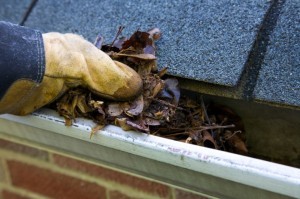
The good news is, whether you’re a commercial enterprise or a homeowner, several tasks done in the off season make it possible to have a healthy and attractive landscape year round. The steps you take to winterize your landscape will become visible throughout the spring and summer. Which projects apply to you?
Paths & Patios
Anywhere you end up walking through mud when you would prefer not to is an opportunity to solve a problem and beautify your surroundings. One solution is the use of paving stones. They drain well, can be configured to an area of any size or shape and offer endess possibilities in creating attractive, affordable walkways, patios, retaining walls and more.
Pruning
Most pruning is done in the winter. It’s important to check trees every year for dangerous, damaged or unattractive limbs or odd growth habits. There may be trees you’d like removed, whether for safety or aesthetic reasons. Whether a tree has outgrown its space, is poorly placed, poses a threat or otherwise just bugs you, doing away with it makes a huge difference in your yard’s appearance.
Winter’s a favorable time for hedge trimming and tree and shrub thinning. Your plantings will look all the better for it next season.
Clean Up
Don’t batten down the hatches until you’ve clear the decks of weeds, fallen leaves and other debris. They spread disease, smother the lawn and increase next year’s slugs and weeds! Watch for hidden nooks and crannies where leaves tend to congregate or weeds go unnoticed. Steps, sidewalks, driveways, decks and patios have been subjected to abuse over the past year and if not tended to now may grow slick and slimy come winter. Moss treatment and/or pressure washing may be in order.
Water Features
If a water feature is large enough, it may be best to keep it running all year, not only for the pump’s sake but for that of the fish. Smaller features should be drained and properly protected for the season.
Irrigation Systems & Drains
It isn’t until the weather gets really wet that we remember that spot in the yard where water always pools or runs in the wrong direction. Let us help you remedy the situation with a free assessment to discover whether you’d benefit from the installation of a drain or culvert. Irrigation systems vary, but most require expressing air through the system to blow out any remaining water.
Gutters
Need we say more?
Lighting
Stroll around to make sure all outdoor lighting is firmly secured and in working order. You may see areas where you could use more lighting. For information on low-voltage landscape lighting, see our recent blog!
Plant Care
Annuals typically die when temperatures drop below freezing; the entire plant should be removed. Perennials may die down, but they will be back bigger and better next year (there’s also time to divide and transplant them). Any dead foliage and surrounding debris should be removed. If you mulch, keep it back from the root crown by a few inches. If a hard frost threatens, it may be a good idea to heap some protection over them such as pine branches, straw or cloth for the duration.
Be Wise: Winterize! Frontier Landscaping has a systemized weatherization program adaptable to any property. Our professionals are well versed in the best practices for every aspect of landscape design and installation, maintenance and expert tree service. Contact us today!
 A simple layer of bark transforms the landscape, can cut water usage up to 50 percent – and lots more!
A simple layer of bark transforms the landscape, can cut water usage up to 50 percent – and lots more!
Bark, whether bark dust, chips, mulch or beauty bark, is produced out of chipped or shredded tree bark. Coarser forms are known as bark nuggets. They all decompose slowly and only need to be reapplied every few years.
Spread between plants in a landscape, bark holds in precious moisture, prevents erosion, insulates and protects plants in weather extremes. A layer discourages weeds and creates a more uniform, serene feel throughout the landscape that accentuates the beauty of your plantings. Here are a few professional pointers for success.
Start with good soil built up with humus, fertilizer and other amendments to foster a complete, living environment for your plants’ roots. Get the ground as weed free as possible. At this time you can apply a pre-emergent herbicide around non-food plants.
While fir is the cheapest, it also gives slivers and is orange in color. If you like to work in the dirt a lot or if kids will be playing in the area, hemlock is a better bet. It is richer looking, doesn’t give slivers and fleas don’t like it either. Then there is nugget bark, awesome for water runoff or windy areas.
As with all mulch, too much can injure plants by keeping the soil too wet and limiting available oxygen to the roots. A couple inches is 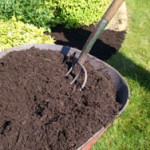 about right; don’t exceed four and leave a few inches of breathing room around the plant’s base. Occasionally, dig down through the mulch to make sure the soil has sufficient moisture and is not harboring pests.
about right; don’t exceed four and leave a few inches of breathing room around the plant’s base. Occasionally, dig down through the mulch to make sure the soil has sufficient moisture and is not harboring pests.
Improperly composted mulches can leach nitrogen from the soil and/or carry loads of viable weed seed; make sure of what you’re getting. Of course, if Frontier Landscaping is doing the job you needn’t worry!
Pile on the benefits in your landscape this year with a blanket of bark!
Even though the ground is cold and the trees are bare, it can be a great time to revamp your landscape. This is a slow season for us landscapers but we are still on the job and don’t mind working in the cold. Don’t wait to schedule your landscape renovation or upgrade! Call us now to save money by scheduling in the off season!
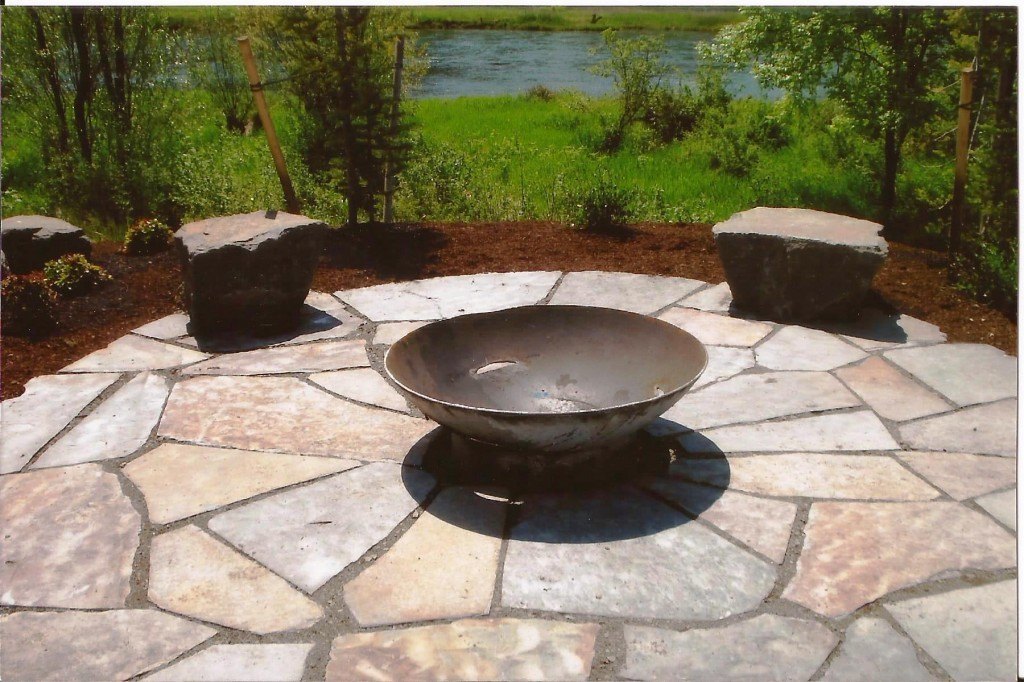
Most of our landscape installation services are doable in winter too! What dreams do you have when you look at your yard? What features have you thought about including? Are there areas to expand? Well, now is the time!
Here are a few ideas to consider:
- Maximize the use of space in your landscape by adding arbors and trellises for climbing roses, clematis and other beautiful vines. We can take care of it, from construction to planting.
- Add a stone patio to make the perfect gathering spot. You can even add a fireplace! We use quality pavers to create a finished look.
- Find that perfect tranquil corner for a pond or waterfall. You could even wind a babbling brook through your property! We install many different types of water features, from top to bottom.
- Plant new trees to enjoy for years to come. Whether you are looking for more shade in your yard or perhaps a focal point for autumn, we can get the trees you need.
Contact Frontier Landscaping today to schedule your landscape construction project. We can discuss all the possibilities and get you on the schedule to take advantage of winter savings.

Other Winter Services:
Frontier Landscape offers a wide range of services all year long.
- Seasonal Clean-ups: We trim back dead plant material, rake leaves, clean gutters and storm drains and then haul it all away, leaving a neat and trim landscape behind.
Contact us today to schedule your landscape service.
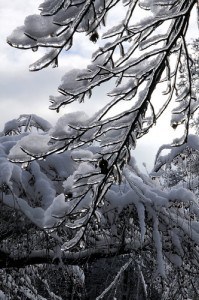 We have officially entered the cold months! Be sure to keep taking care of your landscape throughout the winter. They need your help to survive the cold weather and prepare for a great growing season next spring.
We have officially entered the cold months! Be sure to keep taking care of your landscape throughout the winter. They need your help to survive the cold weather and prepare for a great growing season next spring.
Remember, if you need assistance, you can count on us! Frontier Landscaping is always just a phone call away: (888) 544-5006
Protect Sensitive Plants
Hopefully, most of the plants in your landscape are completely dormant and/or are cold-hardy. But if you have some plants that you know are just barely rated for your zone, take a little extra precaution to help them stay healthy this winter. We highly recommend adding a few inches of mulch around the base of plants to insulate their roots and keep the soil from freezing. You can also cover plants entirely with floating row cover and frost blankets.
Spray Dormant Trees
Spray your fruit trees with dormant spray to help prevent pest infestations in the coming year. Dormant sprays kill off any resting insect eggs and larvae as well as protect from new ones coming in. Spraying will help ensure a healthy, blemish-free crop for the coming year.
It’s Pruning Time
Winter is the best time to prune your fruit trees! They are now dormant and ready to be trimmed back. This is so important for both the shape and size of the tree as well as the future fruit harvest. If you need help, you can call on Frontier Tree Service.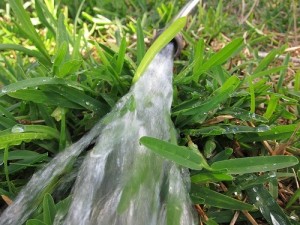
Water in Dry Weather
Though it may be cold out, we have been having some dry spells. In the absence of rain, we recommend watering trees and shrubs once a week. Water right at the soil line to avoid getting leaves wet (this can lead to damage in below-freezing temperatures). A slow drip is the best option to help plants thrive in cold, dry weather.
Prevent Frozen Pipes
Disconnect any outdoor hoses and wrap the faucets in a towel or bubble wrap to keep pipes from freezing. If it’s really cold, you might want to leave your sink cupboards open to let warm air in, and leave a small drip going indoors, to keep water flowing.
Additional Services:
Contact our Landscape Maintenance department for mulching, watering and plant care needs. (888) 544-5006
Contact Frontier Tree Service for pruning, dormant spray and more. (888) 544-5006






















